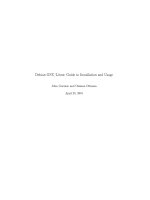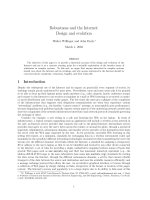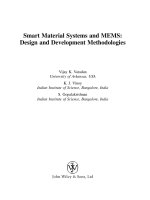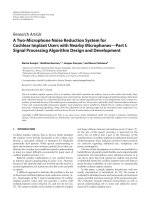EMBEDDED LINUX SYSTEM DESIGN AND DEVELOPMENT.pdf
Bạn đang xem bản rút gọn của tài liệu. Xem và tải ngay bản đầy đủ của tài liệu tại đây (6.42 MB, 429 trang )
Au0586 half title page 11/17/05 2:05 PM Page 1
E
MBEDDED
L
INUX
S
YSTEM
D
ESIGN AND
D
EVELOPMENT
TEAM FLY
Au0586 title page 11/17/05 2:04 PM Page 1
Boca Raton New York
E
MBEDDED
L
INUX
S
YSTEM
D
ESIGN AND
D
EVELOPMENT
P. Raghavan • Amol Lad • Sriram Neelakandan
Published in 2006 by
Auerbach Publications
Taylor & Francis Group
6000 Broken Sound Parkway NW, Suite 300
Boca Raton, FL 33487-2742
© 2006 by Taylor & Francis Group, LLC
Auerbach is an imprint of Taylor & Francis Group
No claim to original U.S. Government works
Printed in the United States of America on acid-free paper
10987654321
International Standard Book Number-10: 0-8493-4058-6 (Hardcover)
International Standard Book Number-13: 978-0-8493-4058-1 (Hardcover)
Library of Congress Card Number 2005048179
This book contains information obtained from authentic and highly regarded sources. Reprinted material is quoted with
permission, and sources are indicated. A wide variety of references are listed. Reasonable efforts have been made to publish
reliable data and information, but the author and the publisher cannot assume responsibility for the validity of all materials
or for the consequences of their use.
No part of this book may be reprinted, reproduced, transmitted, or utilized in any form by any electronic, mechanical, or
other means, now known or hereafter invented, including photocopying, microfilming, and recording, or in any information
storage or retrieval system, without written permission from the publishers.
For permission to photocopy or use material electronically from this work, please access www.copyright.com
( or contact the Copyright Clearance Center, Inc. (CCC) 222 Rosewood Drive, Danvers, MA
01923, 978-750-8400. CCC is a not-for-profit organization that provides licenses and registration for a variety of users. For
organizations that have been granted a photocopy license by the CCC, a separate system of payment has been arranged.
Trademark Notice: Product or corporate names may be trademarks or registered trademarks, and are used only for
identification and explanation without intent to infringe.
Library of Congress Cataloging-in-Publication Data
Raghavan, P. (Pichai), 1973-
Embedded Linux system design and development / P. Raghavan, Amol Lad, Sriram Neelakandan.
p. cm.
Includes bibliographical references and index.
ISBN 0-8493-4058-6 (alk. paper)
1. Linux. 2. Operating systems (Computers) 3. Embedded computer systems. I. Lad, Amol. II.
Neelakandan, Sriram. III. Title.
QA76.76.O63R335 2005
005.4'32--dc22 2005048179
Visit the Taylor & Francis Web site at
and the Auerbach Publications Web site at
Taylor & Francis Group
is the Academic Division of T&F Informa plc.
All source code in the book is released under GNU GPL v2. It can be used as desired under terms and
conditions of GNU GPL v2.
Trademarks
Ⅲ
MIPS is a registered trademark and YAMON is a trademark of MIPS Technologies.
Ⅲ
IBM and ClearCase are registered trademarks and PowerPC is a trademark of International Business
Machines Corporation.
Ⅲ
UNIX is a registered trademark in the United States and other countries, licensed exclusively through
X/Open Company Limited.
Ⅲ
X11 is a trademark of Massachusetts Institute of Technology.
Ⅲ
NEC is a registered trademark of NEC Corporation
Ⅲ
HP is a registered trademark of Hewlett-Packard Company.
Ⅲ
ColdFire is a registered trademark and Motorola is a trademark of Motorola, Inc
Ⅲ
Microblaze is trademark of Xilinx Inc
Ⅲ
Red Hat is a registered trademark and eCos and RedBoot are trademarks of Red Hat, Inc.
Ⅲ
uClinux is a registered trademark of Arcturus Networks Inc
Ⅲ
Linux is a registered trademark of Linus Torvalds
Ⅲ
GoAhead is a registered trademark of GoAhead Software, Inc
Ⅲ
RTLinux is a registered trademark and FSMLabs, RTLinuxPro and RTCore are trademarks of Finite State
Machine Labs, Inc
Ⅲ
Debian is a registered trademark of Software in the Public Interest, Inc
Ⅲ
LMBench is a trademark of BitMover, Inc
Ⅲ
VRTX is a trademark of Microtech Research Inc
Ⅲ
VxWorks and pSOS are registered trademarks of Wind River Systems, Inc
Ⅲ
Trolltech is registered trademark and Qt is a trademark of Trolltech in Norway, the United States and
other countries
Ⅲ
OpenGL is a registered trademark of Silicon Graphics, Inc
Ⅲ
Perforce is a registered trademark of Perforce Software, Inc
Ⅲ
Eclipse is trademark of Eclipse Foundation, Inc
Ⅲ
KDE and K Desktop Environment are trademarks of KDE
Ⅲ
FFmpeg is a trademark of Fabrice Bellard, originator of the FFmpeg project
Ⅲ
NVIDIA is a registered trademark of NVIDIA Corporation in the United States and other countries
Ⅲ
ViewML is a registered trademark of Century Software Inc
Ⅲ
QNX and Neutrino are registered trademarks of QNX Software Systems Ltd
Ⅲ
Nucleus is a trademark of Accelerated Technology, Inc
Ⅲ
Accelerated Technology is a registered trademark of Mentor Graphics Corporation
Ⅲ
ARM and StrongARM are registered trademarks and ARM7 and ARM9 are trademarks of Advanced RISC
Machines, Ltd.
Ⅲ
AMD is a registered trademark of Advanced Micro Devices, Inc.
Ⅲ
Intel and Pentium are registered trademarks and i386 and XScale are trademarks of Intel Corporation.
Ⅲ
Sharp is a registered trademark of Sharp Electronics Corp.
Ⅲ
SPARC is a registered trademark of SPARC International, Inc., and is used under license by Sun
Microsystems, Inc.
Ⅲ
Toshiba is a registered trademark of the Toshiba Corporation.
Ⅲ
MontaVista is registered trademark of MontaVista Software Inc.
Ⅲ
LynxOS and BlueCat are registered trademarks and LynuxWorks, SpyKer and VisualLynux are trademarks
of LynuxWorks, Inc.
Ⅲ
Samsung is a registered trademark of Samsung Electronics America, Inc. and its related entities.
Ⅲ
Ericsson is a registered trademark of Ericsson, Inc.
Ⅲ
Atmel is registered trademarks of Atmel Corporation.
Ⅲ
TimeSys
®
, TimeStorm®, TimeStorm IDE™, TimeStorm LVS™, TimeStorm LDS™, TimeStorm LHD™,
TimeSys Reservations™, TimeTrace
®
, Linux/RT
TM
and TimeWiz
®
are registered or unregistered trademarks
of TimeSys Corporation in the United States and other countries.
Ⅲ
NeoMagic is registered trademark of NeoMagic Corporation.
Ⅲ
Transmeta is a trademark of Transmeta Corporation.
Ⅲ
Broadcom is a registered trademark of Broadcom Corporation and/or its subsidiaries.
Ⅲ
SuSE is a registered trademark of SuSE AG.
vi
Embedded Linux System Design and Development
Ⅲ
Borland is a registered trademark of Borland Software Corporation in the United States and other
countries.
Ⅲ
Merant is a registered trademark of Merant.
Ⅲ
SnapGear is a registered trademark of SnapGear Inc.
Ⅲ
Matsushita is a trademark of the Matsushita Electric Corporation.
Ⅲ
I2C is a trademark of Philips Semiconductors Corporation.
Ⅲ
Philips® is a registered trademark of Philips Consumer Electronics Corporation.
Ⅲ
Cadenux is a trademark of Cadenux, LLC.
Ⅲ
ELinOS is a registered trademark of SYSGO AG.
Ⅲ
Metrowerks and CodeWarrior are trademarks of Metrowerks Corp. in the U.S. or other countries.
Ⅲ
FreeBSD is a registered trademark of the FreeBSD Foundation.
Ⅲ
IEEE and POSIX are registered trademarks of Institute of Electrical and Electronics Engineers, Inc. in
the United States.
Ⅲ
Xtensa is a trademark belonging to Tensilica Inc.
Ⅲ
Fujitsu is a registered trademark of Fujitsu, Ltd.
Ⅲ
Firewire is a registered trademark of Apple computer.
Ⅲ
SuperH is a trademark of Hitachi, Ltd.
Ⅲ
Windows, WinCE and Microsoft are registered trademarks and MS-DOS and DirectX .are trademarks of
Microsoft Corporation.
Ⅲ
Solaris and Java are registered trademarks and ChorusOS is a trademark of Sun Microsystems, Inc. in
the U.S. or other countries.
Ⅲ
Symbian is a trademark of Symbian Ltd.
vii
Dedication
Raghavan
In memory of my late father
Amol
To Lord Krsna,
...
my parents, my wife Parul, and my brother Amit
Sriram
To my family and all Linux enthusiasts
ix
Contents
1
Intr oduction ............................................................................................. 1
1.1 History of Embedded Linux .................................................... 2
1.1.1 Year 1999 ..................................................................... 3
1.1.2 Year 2000 ..................................................................... 4
1.1.3 Year 2001 ..................................................................... 4
1.1.4 Year 2002 ..................................................................... 5
1.1.5 Year 2003 ..................................................................... 6
1.1.6 Year 2004 ..................................................................... 6
1.2 Why Embedded Linux? ............................................................ 7
1.2.1 Vendor Independence................................................. 7
1.2.2 Time to Market............................................................ 8
1.2.3 Varied Hardware Support ........................................... 8
1.2.4 Low Cost ...................................................................... 8
1.2.5 Open Source................................................................ 9
1.2.6 Standards (POSIX®) Compliance............................. 10
1.3 Embedded Linux Versus Desktop Linux .............................. 10
1.4 Frequently Asked Questions.................................................. 11
1.4.1 Is Linux Too Large?................................................... 11
1.4.2 Is Linux Real-Time Enough?..................................... 11
1.4.3 How Can I Protect My Proprietary Software?......... 12
1.4.4 Should I Buy a Commercial Embedded
Linux Distribution?..................................................... 12
1.4.5 Which Embedded Linux Distribution Do I
Choose? ...................................................................... 12
1.5 Embedded Linux Distributions .............................................. 13
1.5.1 BlueCat Linux ............................................................ 14
1.5.2 Cadenux ..................................................................... 15
1.5.3 Denx........................................................................... 17
x Embedded Linux System Design and Development
1.5.4 Embedded Debian (Emdebian)................................ 18
1.5.5 ELinOS (SYSGO) ....................................................... 19
1.5.6 Metrowerks ................................................................ 20
1.5.7 MontaVista Linux....................................................... 22
1.5.8 RTLinuxPro™ ............................................................. 23
1.5.9 TimeSys Linux............................................................ 24
1.6 Porting Roadmap .................................................................... 26
Notes ................................................................................................. 28
2
Getting Started ........................................................................................ 29
2.1 Architecture of Embedded Linux .......................................... 29
2.1.1 Real-Time Executive.................................................. 29
2.1.2 Monolithic Kernels .................................................... 30
2.1.3 Microkernel ................................................................ 31
2.2 Linux Kernel Architecture...................................................... 32
2.2.1 Hardware Abstraction Layer (HAL).......................... 33
2.2.2 Memory Manager....................................................... 33
2.2.3 Scheduler.................................................................... 34
2.2.4 File System................................................................. 35
2.2.5 IO Subsystem............................................................. 36
2.2.6 Networking Subsystems ............................................ 36
2.2.7 IPC .............................................................................. 36
2.3 User Space .............................................................................. 36
2.4 Linux Start-Up Sequence........................................................ 41
2.4.1 Boot Loader Phase .................................................... 42
2.4.2 Kernel Start-Up .......................................................... 43
2.4.3 User Space Initialization ........................................... 47
2.5 GNU Cross-Platform Toolchain ............................................. 48
2.5.1 Building Toolchain .................................................... 50
2.5.2 Building Toolchain for MIPS .................................... 55
3
Boar d Support Package ......................................................................... 59
3.1 Inserting BSP in Kernel Build Procedure............................. 60
3.2 The Boot Loader Interface..................................................... 62
3.3 Memory Map........................................................................... 66
3.3.1 The Processor Memory Map — MIPS Memory
Model.......................................................................... 67
3.3.2 Board Memory Map .................................................. 68
3.3.3 Software Memory Map.............................................. 68
3.4 Interrupt Management............................................................ 72
3.5 The PCI Subsystem................................................................. 77
3.5.1 Uniqueness of PCI Architecture............................... 77
3.5.2 PCI Software Architecture......................................... 79
Contents xi
3.6 Timers...................................................................................... 81
3.7 UART ....................................................................................... 81
3.7.1 Implementing the Console ....................................... 81
3.7.2 The KGDB Interface ................................................. 82
3.8 Power Management................................................................ 83
3.8.1 Hardware and Power Management ......................... 83
3.8.2 Power Management Standards ................................. 85
3.8.3 Supporting Processor’s Power-Saving Modes ......... 86
3.8.4 Unified Driver Framework for Power
Management............................................................... 87
3.8.5 Power Management Applications............................. 88
4
Embedded Storage ................................................................................. 89
4.1 Flash Map................................................................................ 89
4.2 MTD—Memory Technology Device...................................... 91
4.2.1 The MTD Model ........................................................ 91
4.2.2 Flash Chips ................................................................ 92
4.2.3 Flash Disks................................................................. 92
4.3 MTD Architecture ................................................................... 94
4.3.1
mtd_info
Data Structure ......................................... 96
4.3.2 Interface Between MTD Core and Low-Level
Flash Drivers.............................................................. 96
4.4 Sample MTD Driver for NOR Flash...................................... 97
4.5 The Flash-Mapping Drivers ................................................. 106
4.5.1 Filling up
mtd_info
for NOR Flash Chip ............ 106
4.5.2 Filling up
mtd_info
for NAND Flash Chip ......... 108
4.5.3 Registering
mtd_info
.............................................. 109
4.5.4 Sample Mapping Driver for NOR Flash ................ 111
4.6 MTD Block and Character Devices..................................... 114
4.7 Mtdutils Package................................................................... 116
4.8 Embedded File Systems ....................................................... 116
4.8.1 Ramdisk.................................................................... 117
4.8.2 RAMFS ...................................................................... 117
4.8.3 CRAMFS (Compressed RAM File System) ............. 117
4.8.4 Journaling Flash File Systems — JFFS and
JFFS2......................................................................... 117
4.8.5 NFS — Network File System.................................. 119
4.8.6 PROC File System.................................................... 119
4.9 Optimizing Storage Space.................................................... 120
4.9.1 Kernel Space Optimization..................................... 120
4.9.2 Application Space Optimization............................. 121
4.9.3 Applications for Embedded Linux ......................... 122
4.10 Tuning Kernel Memory........................................................ 124
xii Embedded Linux System Design and Development
5
Embedded Drivers ............................................................................... 127
5.1 Linux Serial Driver................................................................ 128
5.1.1 Driver Initialization and Start-Up ........................... 130
5.1.2 Data Transmission ................................................... 134
5.1.3 Data Reception ........................................................ 134
5.1.4 Interrupt Handler..................................................... 134
5.1.5 Terminos Settings .................................................... 138
5.2 Ethernet Driver ..................................................................... 138
5.2.1 Device Initialization and Clean-Up........................ 140
5.2.2 Data Transmission and Reception ......................... 142
5.3 I2C Subsystem on Linux ...................................................... 144
5.3.1 I2C Bus..................................................................... 145
5.3.2 I2C Software Architecture....................................... 147
5.4 USB Gadgets ......................................................................... 152
5.4.1 USB Basics ............................................................... 153
5.4.2 Ethernet Gadget Driver........................................... 158
5.5 Watchdog Timer ................................................................... 161
5.6 Kernel Modules..................................................................... 162
5.6.1 Module APIs ............................................................ 162
5.6.2 Module Loading and Unloading ............................ 164
Notes ............................................................................................... 164
6
Porting Applications ............................................................................ 165
6.1 Architectural Comparison..................................................... 165
6.2 Application Porting Roadmap.............................................. 166
6.2.1 Decide Porting Strategy .......................................... 167
6.2.2 Write an Operating System Porting Layer
(OSPL) ...................................................................... 169
6.2.3 Write a Kernel API Driver ...................................... 170
6.3 Programming with Pthreads ................................................ 171
6.3.1 Thread Creation and Exit ....................................... 172
6.3.2 Thread Synchronization .......................................... 174
6.3.3 Thread Cancellation ................................................ 180
6.3.4 Detached Threads ................................................... 181
6.4 Operating System Porting Layer (OSPL)............................. 182
6.4.1 RTOS Mutex APIs Emulation.................................. 182
6.4.2 RTOS Task APIs Emulation .................................... 185
6.4.3 IPC and Timer APIs Emulation .............................. 191
6.5 Kernel API Driver................................................................. 191
6.5.1 Writing User-Space Stubs........................................ 194
6.5.2 Kapi Driver Implementation................................... 195
6.5.3 Using the Kapi Driver............................................. 199
Note................................................................................................. 200
Contents xiii
7
Real-Time Linux ................................................................................... 201
7.1 Real-Time Operating System ............................................... 202
7.2 Linux and Real-Time ............................................................ 202
7.2.1 Interrupt Latency ..................................................... 203
7.2.2 ISR Duration ............................................................ 204
7.2.3 Scheduler Latency.................................................... 205
7.2.4 Scheduler Duration.................................................. 207
7.2.5 User-Space Real-Time ............................................. 209
7.3 Real-Time Programming in Linux ....................................... 209
7.3.1 Process Scheduling.................................................. 210
7.3.2 Memory Locking...................................................... 213
7.3.3 POSIX Shared Memory ........................................... 223
7.3.4 POSIX Message Queues.......................................... 225
7.3.5 POSIX Semaphores.................................................. 232
7.3.6 Real-Time Signals .................................................... 233
7.3.7 POSIX.1b Clock and Timers................................... 241
7.3.8 Asynchronous I/O ................................................... 246
7.4 Hard Real-Time Linux .......................................................... 252
7.4.1 Real-Time Application Interface (RTAI)................. 253
7.4.2 ADEOS...................................................................... 258
8
Building and Debugging ...................................................................... 261
8.1 Building the Kernel .............................................................. 263
8.1.1 Understanding Build Procedure............................. 265
8.1.2 The Configuration Process...................................... 266
8.1.3 Kernel Makefile Framework ................................... 268
8.2 Building Applications ........................................................... 270
8.2.1 Cross-Compiling Using Configure.......................... 273
8.2.2 Troubleshooting Configure Script .......................... 274
8.3 Building the Root File System............................................. 275
8.4 Integrated Development Environment................................ 278
8.4.1 Eclipse ...................................................................... 279
8.4.2 KDevelop ................................................................. 279
8.4.3 TimeStorm ................................................................ 279
8.4.4 CodeWarrior ............................................................. 280
8.5 Debugging Virtual Memory Problems ................................ 280
8.5.1 Debugging Memory Leaks...................................... 282
8.5.2 Debugging Memory Overflows.............................. 286
8.5.3 Debugging Memory Corruption ............................. 287
8.6 Kernel Debuggers................................................................. 291
8.7 Profiling ................................................................................. 293
8.7.1 eProf—An Embedded Profiler................................ 294
8.7.2 OProfile .................................................................... 300
xiv Embedded Linux System Design and Development
8.7.3 Kernel Function Instrumentation ........................... 302
Notes ............................................................................................... 308
9
Embedded Graphics ............................................................................. 309
9.1 Graphics System ................................................................... 309
9.2 Linux Desktop Graphics—The X Graphics System........... 311
9.2.1 Embedded Systems and X...................................... 312
9.3 Introduction to Display Hardware ...................................... 313
9.3.1 Display System ........................................................ 313
9.3.2 Input Interface ......................................................... 316
9.4 Embedded Linux Graphics .................................................. 316
9.5 Embedded Linux Graphics Driver ...................................... 316
9.5.1 Linux Frame Buffer Interface ................................. 317
9.5.2 Frame Buffer Internals ............................................ 326
9.6 Windowing Environments, Toolkits, and Applications ..... 328
9.6.1 Nano-X ..................................................................... 335
9.7 Conclusion............................................................................. 340
Notes ............................................................................................... 340
10
uClinux ................................................................................................. 341
10.1 Linux on MMU-Less Systems............................................... 341
10.1.1 Linux Versus uClinux .............................................. 342
10.2 Program Load and Execution.............................................. 343
10.2.1 Fully Relocatable Binaries (FRB)............................ 345
10.2.2 Position Independent Code (PIC).......................... 345
10.2.3 bFLT File Format ..................................................... 346
10.2.4 Loading a bFLT File ................................................ 347
10.3 Memory Management........................................................... 358
10.3.1 Heap ......................................................................... 358
10.3.2 Stack ......................................................................... 363
10.4 File / Memory Mapping—The Intricacies of mmap( )
in uClinux ............................................................................. 364
10.5 Process Creation ................................................................... 365
10.6 Shared Libraries .................................................................... 367
10.6.1 uClinux Shared Library Implementation
(libN.so).................................................................... 367
10.7 Porting Applications to uClinux.......................................... 370
10.7.1 Creating uClinux Programs..................................... 370
10.7.2 Creating Shared Libraries in uClinux..................... 371
10.7.3 Using Shared Library in an Application ................ 373
10.7.4 Memory Limitations................................................. 375
10.7.5 mmap Limitations .................................................... 375
10.7.6 Process-Level Limitations ........................................ 375
Contents xv
10.8 XIP—eXecute In Place......................................................... 375
10.8.1 Hardware Requirements ......................................... 377
10.8.2 Software Requirements ........................................... 378
10.9 Building uClinux Distribution.............................................. 378
Notes ............................................................................................... 380
Appendices
A
Booting Faster ...................................................................................... 383
Techniques for Cutting Down Bootloader Initialization............. 384
Tuning Kernel for Decreased Boot-Up Time .............................. 385
Tuning User Space for Decreased Boot-Up Time ...................... 385
Measuring Boot-Up Time .............................................................. 386
B
GPL and Embedded Linux ................................................................... 387
User-Space Applications ................................................................ 387
Kernel.............................................................................................. 388
Points to Remember ...................................................................... 389
Notes ............................................................................................... 390
Index
............................................................................................................ 391
xvii
Foreword
The industrial revolution appears as a knife-edge change from a rural self-
employed lifestyle to a clock-punching, whistle-blowing corporate urban way
of life. Being in the middle of the current revolution makes it hard to realize
that in fifty years most people will consider the messy, dynamic, no-rules
embedded product development environment of today as an obvious clean
transition caused by technological changes.
The first embedded software project I worked on didn’t use an off-the-
shelf operating system—there was none. It wasn’t until several years later that
WindRiver introduced VxWorks
®
. In the mid-1990s it appeared that nothing
could unseat VxWorks; yet, recently WindRiver announced a Linux-based
product. Why the change? Today the most common embedded operating
system used in new products is Linux.
For fourteen years I was part of a small army of firmware engineers working
on the development of HP LaserJet™ printers. The printer used a homegrown
operating system that as I recall was called LaserJet O.S. Usually the very best
engineers worked on supporting and extending the operating system. Any
LaserJet O.S. documentation that existed, engineers had created. Any test suite
was similarly a burden placed on the engineer’s shoulders. The effort and
expense of these highly talented engineers seldom led to any features that
differentiated the product from the competitors. The most important lesson I
learned from the experience was to always put your most talented engineers
on the features that make your product unique and outsource the infrastruc-
ture. Embedded Linux is often the best choice for the operating system
infrastructure for products needing nontrivial connectivity.
Whether you support Linux in-house or purchase a Linux board support
package for your processor, you will still need to understand the overall system
and at times the details of a particular subsystem. In this book the authors
have done a good job fitting all the pieces together that are necessary for
embedded Linux development. The book discusses topics such as board
support packages, embedded storage, and real-time Linux programming in
xviii Embedded Linux System Design and Development
depth. Embedded graphics and uClinux are also explained with clarity. The
book is a good attempt to address the concerns of an embedded Linux
developer.
The rapid growth of Linux as the top choice for an embedded operating
system in new products is in part due to the ease of using embedded Linux
to replace homegrown operating systems. Although this book is specifically
for running Linux on embedded systems it can also be used as a guide to
port a system from a traditional RTOS or homegrown operating system to
embedded Linux. It may be the need for TCP/IP networking, USB support,
SecureDigital support, or some other standard that causes a company to dump
their current operating system and switch to Linux. But it is the joy of
developing with Linux that keeps the engineers promoting it for future
products.
An astounding amount of Linux information is available on the Web. I
suspect it is the most extensively documented software ever. How can a book
about embedded Linux provide value over what is already available? First, the
scope of embedded Linux and related applications is so large that getting a
feel for what is available and what can be done is challenging. Seeing all the
pieces separately and working together can help you make sense of the
embedded Linux ecosystem. Second, there are technical reasons for needing
the right information. In an embedded device, the bootloader, kernel, and file
system containing the applications all need to be developed in concert for
the solution to work properly. Understanding the interdependencies and
getting the development environment to properly build all three images is not
straightforward. Also, when you encounter a problem, understanding the tools
available to debug the problem and knowing the techniques used for debug-
ging embedded devices can save a significant amount of time and effort.
Finally, the best reason for reading this book on embedded Linux is because
the technology is so fascinating. Anyone who had developed embedded
products the old way, with one single executable image, will be amazed at
the flexibility and power of using embedded Linux. Anyone new to embedded
development will find most of the power and flexibility available on their
desktop PC works the same in their embedded development environment.
Todd Fischer
President and Founder
Cadenux
xix
Preface
When we were in college in the mid-1990s we heard of an exciting new
technology called the Internet that was to have a profound impact on our
lives. Along with the Internet we also heard of an open source operating
system, Linux, which was being developed by hundreds of programmers
around the world. Linux gave us an opportunity to understand the internals
of the operating system and we quickly became Linux enthusiasts. We realized
that Linux was more than an operating system; here was a movement with
few parallels in human history as it was based on the concepts of human
dignity, choice, and freedom. Linux gave young programmers like us the reach
to the latest technology.
When we became embedded professionals Linux had yet to make a strong
presence in the embedded market. However, we were hearing of some exciting
improvements such as running a hard real-time kernel along with the Linux
kernel and running Linux on MMU-less microcontrollers. Our happiness grew
unbounded when we were asked by a customer to move our software on a
MIPS-based SoC from a commercial RTOS to embedded Linux. Our experience
revealed that the road to embedded Linux is not a very smooth ride. Some
of the main reasons were:
1. There is undoubtedly lots of information about embedded Linux on the
Internet but it is too scattered to give a consolidated view. Converting this
information into a knowledge base can be a time-consuming task. Most
of the product-based companies are normally short on time. Decisions
need to be made quickly and executed quickly. However, a wrong decision
especially on crucial issues such as licensing can prove disastrous to the
company.
2. There is a gross misconception that embedded systems are all about the
hardware or the operating system. As computing power increases rapidly
as per Moore’s law the amount of application software that goes into the
embedded system has also increased at the same rate. Hence the appli-
cations have become the USP for the embedded system. So building a
xx Embedded Linux System Design and Development
Linux-based embedded system does not stop with the OS but has to do
a lot with writing and building applications. And applications have their
own set of issues that are different from the operating system such as
licensing, toolchains, and so on.
3. Unlike a commercial RTOS, which gives a single point of support such as
patches and documentation, embedded Linux takes a whole new devel-
opment paradigm. Often the developers need to search for patches or for
new information from the various mailing lists. And this can be very time
consuming.
When we came out successfully with an embedded Linux design with a
variety of applications, we decided to share some of our thoughts and
experiences with the rest of the world. The result of that thought process is
this book. This book contains an entire development roadmap for embedded
Linux systems. Our primary aim is to make the reader aware of the various
issues that arise out of embedded Linux development.
The theme of the book is twofold:
Ⅲ To facilitate movement to embedded Linux from a traditional RTOS
Ⅲ To explain the system design model with embedded Linux
Benefits to the Reader
The book offers solutions to problems that a developer faces when program-
ming in an embedded Linux environment. Some of the common problems are:
Ⅲ Understand the embedded Linux development model.
Ⅲ Write, debug, and profile applications and drivers in embedded Linux.
Ⅲ Understand embedded Linux BSP architecture.
The book offers practical solutions to the above problems.
After reading this book the reader will
Ⅲ Understand the embedded Linux development environment.
Ⅲ Understand and create Linux BSP for a hardware platform.
Ⅲ Understand the Linux model for embedded storage and write drivers and
applications for the same.
Ⅲ Understand various embedded Linux drivers such as serial, I2C, and so on.
Ⅲ Port applications to embedded Linux from a traditional RTOS.
Ⅲ Write real-time applications in embedded Linux.
Ⅲ Learn methods to find memory leaks and memory corruption in applica-
tions and drivers.
Ⅲ Learn methods to profile applications and the kernel.
Ⅲ Understand uCLinux architecture and its programming model.
Ⅲ Understand the embedded Linux graphics subsystem.
Preface xxi
The book is also an aid to managers in choosing an embedded Linux
distribution, creating a roadmap for the transition to embedded Linux, and
applying the Linux licensing model in a commercial product.
Audience
Primary Audience
Ⅲ Architects: They are more concerned with real-time issues, performance,
and porting plans.
Ⅲ Software programmers: They need to get into the minute details of the
technology.
Secondary Audience
Ⅲ Legal staff: Because most embedded products involve intellectual property,
any wrong understanding of the licensing issues can prove detrimental to
the company itself.
Ⅲ Managers: They are normally concerned about choosing the distribution,
version, toolset, and vendor.
Ⅲ Testing and support team: Because the look and feel of the product can
change when moving to embedded Linux, the test and support team needs
to be educated.
Background
The authors expect a basic understanding of embedded system programming
in any embedded OS from the reader. The book is not a Linux kernel book.
Familiarity with basic Linux kernel concepts and the user-space programming
model is desirable.
The book attempts to be independent of the kernel version; however,
wherever necessary the 2.4 or the 2.6 kernels are used as examples.
Downloading Source Code
Readers can download source code from the following URL: http://www.
crcpress.com/e_products/downloads/download.asp?cat_no=AU0586
xxiii
Acknowledgments
I thank the management of my present employer, Philips, for giving me the
support to go ahead with the book. Any work of mine has always been
incomplete without the blessings of my dear mother. And last but not least I
would like to thank my wife, Bhargavi, for spending some cold days alone
when I was busy penning down the pages for this book.
Raghavan
I would like to thank all the people who made this work possible. First my
mother, who used to tell me to work for the book whenever she saw me
roaming here and there, like any mother telling her kid to study. I also express
thanks to my father who kept on asking me about the status of the manuscript,
like a project manager. I thank my wife, Parul, for her patience during
manuscript preparation. I remember when Raghav told me about this project
and asked me to join. It was just two months after my marriage. I thank Parul
for her encouragement and also thank her for helping me out in formatting
the manuscript.
Amol
Thanks to Raghav who had the idea of writing this book. I still remember
the first meeting when he instilled the confidence in me to take up this work.
I thank my dad, mom, and sister for their support. Thanks to the entire “boys”
gang at Bangalore who have been kind enough to share the powerful
“Athlon/Audigy/ATI Radeon 9500” game PC for mean activities such as running
Linux and typing sample code. They consider running a word processor on
such a PC as a gross waste of computing power.
Sriram
We take this opportunity to thank Todd Fischer, president and founder,
Cadenux, for giving us time from his busy schedule to write the foreword for
the book. We thank David McCullogh, one of the uClinux core maintainers,
xxiv Embedded Linux System Design and Development
and Dr. Paul Dale for reviewing the chapter on uClinux and for providing
their valuable comments. We also thank Greg Haerr, CEO of Century Software
and founder of the Nano-X windowing system, for his valuable review com-
ments on the embedded graphics chapter. We thank Satish MM, director of
Verismo Networks, for his valuable comments on GPL. We thank our close
friend and guide, Deepak Shenoy, for coming up with the idea to write a
book based on our development experience. Finally we thank all Linux kernel
developers and user-space programmers for taking Linux to new heights.









